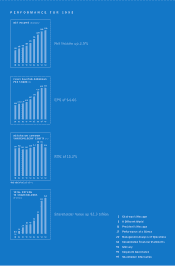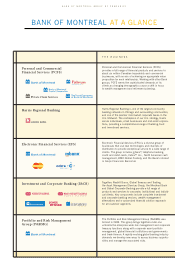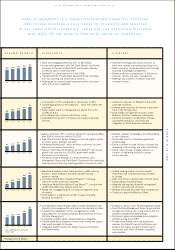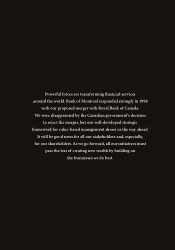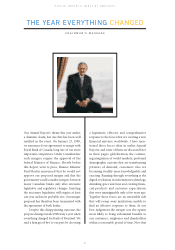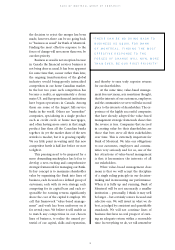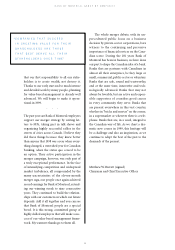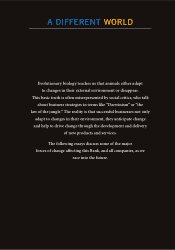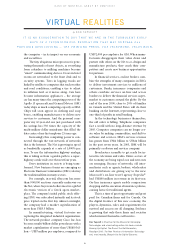Bank of Montreal 1998 Annual Report Download - page 12
Download and view the complete annual report
Please find page 12 of the 1998 Bank of Montreal annual report below. You can navigate through the pages in the report by either clicking on the pages listed below, or by using the keyword search tool below to find specific information within the annual report.
8
BANK OF MONTREAL GROUP OF COMPANIES
more stable and successful than a system restric-
ted
to elites or autocrats; second, that the aver-
age person is sensible enough to choose their
nation’s leaders; and third, that the system will
offer voters some reasonable options based on
widely disseminated information.
Is that a good model for financial services?
We believe it is.
The story of the global financial services
industry in the 1990s has been that democratiza-
tion
of the system works – mostly well – whereas
elitism, authoritarianism and secrecy fail – some-
times
horribly. As savers in North America and
Europe found an increasing array of choices in
financial products and an increasing range of
financial information, they diversified their
sav
ings programs, moving away from excessive
dependence on bank deposits and GICs. At a
time when demographics favoured the growth
of retirement savings vehicles, the mutual fund
industry became the leading collector of per-
sonal savings because the diversity of its prod-
uct lines let people make both short-term and
long-term asset mix decisions. By early 1998,
Canadians had more invested in mutual funds
than in GICs – for the first time ever.
In contrast, most financial systems in Asia
and Eastern Europe that were based on elites
and autocracy have collapsed, wiping out the
savings of generations. When a new form of
financial challenge – deflation – was spawned
in the long Japanese bear market, the ruling
elites in the new economies and new capital
markets of Asia were unable to adapt, and the
consequences proved catastrophic for more
than a billion people who had worked hard and
saved heroically.
1998 was the year in which governments,
central bankers, politicians and investors had
to rethink their tactics and policies in the light
of global secular deflation. This new challenge
to price stability broke out spectacularly after
Thailand was forced to abandon support of its
currency. That breakdown triggered currency
collapses across Asia, which sent those dynamic
economies reeling. Falling currencies, falling
commodity prices and falling stock markets
became the pattern in 1998, particularly after
Russia defaulted on its loans.
The good news for investors was the surge
in bond markets in the industrialized nations.
Investors who had assumed that bonds would
slump when the U.S. economic recovery extended
into its eighth year were surprised when falling
inflation triggered a powerful bond rally that
produced inverted yield curves in Canada, the
United States and Britain.
Bond mutual funds handily outperformed
equity funds, for most of 1998, which demon-
strated anew the value of diversification.
This is the first economic cycle in which
a majority of North American investors have
been able to get the information and products
needed to make them feel comfortable about
actively allocating their savings among a wide
range of vehicles.
Although the setback in equity markets has
bankrupted some high-flying speculators and
unnerved many professional investors, most
people who began buying mutual funds in this
cycle have not abandoned equities. They learned
about reward during the long bull market, and
they are now learning about risk. Learning the
first lesson is easy and pleasurable. Learning the
second lesson can be difficult and painful.
As 1999 dawns, investors must learn about
new risks, including Year 2000 computer prob-
lems and recessions or depressions across the
developing world. However these forces play
out, they will not drive personal investing back
to the old ways. GICs have come back in popu-
larity in recent months, not because they are
all that is available, but because their high real
rates of return and price stability are attractive
portfolio features.
Diversity and individual freedom of choice
have, for better or worse, for richer or poorer,
become the new personal investing style. It is
the worst personal savings system, except for all
the others that have been tried.
Donald Coxe is Chairman and Chief Strategist for Harris
Investment Management and Chairman of Jones Heward
Investments Inc., the two money management groups in the
Bank of Montreal Group of Companies. He is also a regular
columnist for The Globe and Mail.
CAPITAL CHANGE
by DONALD COXE
DEMOCRACY HAS BEEN DESCRIBED AS THE WORST POLITICAL SYSTEM, EXCEPT
FOR ALL THE OTHERS THAT HAVE BEEN TRIED. IT IS BASED ON THREE ASSUMPTIONS:
FIRST, THAT A SYSTEM IN WHICH POWER IS BROADLY DIFFUSED WILL BE


